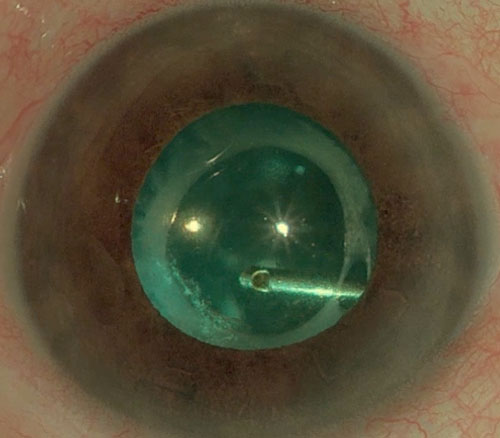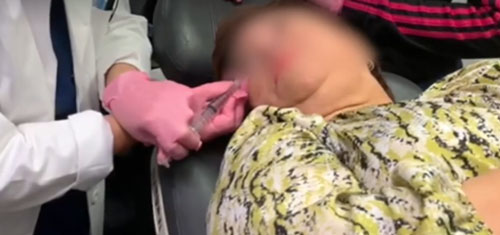Chapter 33
In Office Vitreoretinal Surgical Procedures
In-office procedures for complications after vitreoretinal surgeries can be time and cost-efficient and can avoid a reoperation. Some of the complications that can be treated in-office include recurrent vitreous hemorrhage, gas complications, retained perfluorocarbon liquids, and complications associated with silicone oil.
For mild hemorrhages in pseudophakic eyes an ND:YAG peripheral capsulotomy can be performed, opening both the anterior and posterior capsules peripheral to the edge of the IOL. This allows red blood cells to pass into the anterior chamber and clear through the trabecular meshwork. The technique involves dilation of the eye, then treating one or two areas around the intra-ocular lens optic, creating an opening of 2-3 mm.
1. ND:YAG Peripheral Capsulotomy (Figure 33.1)
2. In-office Fluid-air Exchange (Figure 33.2)
For recurrent dense hemorrhages, or hemorrhages in either phakic or pseudophakic eyes. The single syringe approach is described below.
- Apply topical anesthesia and 2 drops of 5% povidone iodine
- Wait 5 minutes then place a lid speculum followed by 1 drop of 5% povidone iodine
- Recline the patient and have the head tilted sideways so that the side of the eye treated is closer to the floor
- Fill a 10 cc(mL) syringe with filtered air to 6 cc(mL), remove the filter, and place a 27-gauge needle on the syringe
- Position the syringe perpendicular to the floor and enter the eye from the inferotemporal quadrant, aiming at the center of the globe
- Aspirate fluid (gravity will force the fluid to accumulate at the base of the syringe)
- As the eye starts to become soft, inject air into the eye
- Continue to aspirate more fluid
- Repeat the cycle until no more fluid is aspirated or until 5 cc(mL) of fluid has been removed
- Take the plunger back to the original starting point of 6 cc(mL)
- Remove the needle and press the area with a sterile cotton tip applicator
- Use indirect ophthalmoscopy to examine the retina and check the intraocular pressure
If inadequate gas fill is noted in the post-op period after vitrectomy (in the form of a small bubble), the same technique described above of fluid-air exchange is used, except instead of air, a filtered gas mixture is utilized. Injecting 0.9 cc(mL) of pure gas through the pars plana can also be performed, with withdrawal of gas to keep the intraocular pressure (IOP) in the normal range.
If excessive gas is noted post-op, with elevated IOP and a shallow anterior chamber, removal of 0.9cc(ml) of intravitreal gas can be performed through the pars plana with a syringe and a 30-gauge needle.
All rights reserved. No part of this publication which includes all images and diagrams may be reproduced, distributed, or transmitted in any form or by any means, including photocopying, recording, or other electronic or mechanical methods, without the prior written permission of the authors, except in the case of brief quotations embodied in critical reviews and certain other noncommercial uses permitted by copyright law.
Westmead Eye Manual
This invaluable open-source textbook for eye care professionals summarises the steps ophthalmologists need to perform when examining a patient.



